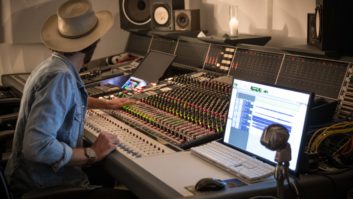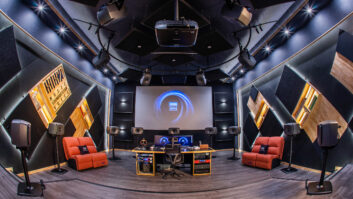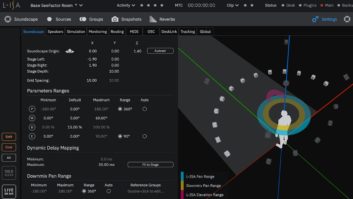Austin, TX—Austin officially adopted its “Live Music Capital of the World” motto in 1991 for good reason, as it has a reported 100 venues hosting performances on any given night. The city’s active music scene has long overshadowed the local recording business, but in the Hyde Park neighborhood south of downtown Austin, one recording studio is hoping to turn that around.
“It’s a city so focused on live music that the recording industry almost plays second fiddle,” says Alex Lyon, co-owner, with Chris “Frenchie” Smith, of The Bubble. “We’d like to change that. We hope to make Austin take it more seriously and step up the game for the whole community.”
Smith launched The Bubble in 1998 in a downtown Austin warehouse shortly before his band, Sixteen Deluxe, started to wind down, says Lyon, who relocated there in 2002. “I ran into a friend from New York in a bar here who was working at The Bubble. I was looking for a place to call home,” he says. He partnered with Smith and they’ve worked together ever since.

In 2005, Lyon bought a property in Hyde Park and turned the building behind his new home into a studio. The conversion was overseen by renowned Austin-based Mark Genfan’s Acoustic Spaces sound design consultancy.
With the birth of Lyon’s twin daughters in 2013, he decided to forgo the 14-hour days in the studio and transition into mastering, calling in Genfan to design and build a ground-up facility on the property. “The mastering is a standalone business,” says Lyon, although he’s happy to offer Bubble’s recording clients a package deal. “I didn’t really know what I was getting in to and it took a while to figure it out, but I’m pretty happy with it.” And the hours are better, he says.
The Bubble is located at a busy intersection, and with the twins growing up, Lyon thought it best to relocate his family. “So we got Mark on board and started the process of turning a 1923 house that hadn’t been updated much into a 2019 recording studio,” he says.
The planning and permitting process was long and arduous. Then, in December 2018, Genfan and his wife, Alisin, were found dead after their pickup truck was swept off the road by a flash flood.
Couple Found Dead After Flash Flooding Leaves Lasting Impact on Austin Music Scene, by Melanie Barden, CBS Austin, Dec. 10, 2018
“I was fortunate in that I had his plans and I was using the crew that he always used for buildouts, so they knew what he would want and how to finish some of the things that were left unfinished. But it was tragic; I was tight with Mark,” says Lyon.

Unfortunately, the electrical wiring and plumbing, little changed since 1923, had to be completely replaced. In Texas, interior walls in that era often were finished with shiplap, a weathertight, overlapping board construction originally used on, obviously, ships. “All that wood you see in the control room is from this house; we reused it,” he says. Noting that the living room and an upstairs bedroom were combined into the double-height live room, he adds, “That wood in the live room is sourced from demolished houses and barns here. It has a vibe and sounds really good.”
API Bursts Into Bubble, April 13, 2001
The new facility is now The Bubble’s main room. As for the original studio out back, “That will be a B control room, probably with just a computer rig, and upstairs will be an apartment,” says Lyon.
You might think he would be sick of construction, but he says, “I’d really like to get a reverb chamber built. It’s not going to happen anytime soon, but it’s on the five-year plan,” though he wishes Genfan was still around to build it.
The Bubble was one of the first customers for API’s 1608 mixing console when it became available. That desk has been moved to the new A room and extended to 32 inputs, but not without another glitch. “I called Vintage King and they told me that API had just announced their Model II and they weren’t making the expander anymore. I checked on eBay, found one and bought it.”
He continues, “We like the preamps, in that world between Neve and SSL, and the idea of the 500 series modules, so that you can customize it, in a way. But the biggest thing is that if something breaks, you can call API and they will fix it.”
The new room is dominated by a large pair of in-wall Urei 813 main monitors. “I got those off eBay as well. They came from Ocean Way” in Los Angeles. “They were rear speakers [from a quad system], so they’re not that beat up,” Lyon reports. Pelonis PSS110-P and Yamaha NS-10 nearfields are also available on site.

Pro Tools HDX is the workstation of choice at The Bubble, though there was an in-house 24-track machine for a while. “We don’t do 2-inch anymore. People can’t afford tape, and it’s not quite as good as it used to be.” However, says Lyon, “In the mastering room, I have two Mara Machines—a half-inch and a quarter-inch. I did a blues session recently and ran the quarter-inch at 15 ips. That did the trick.”
All the outboard equipment was moved from the original studio into the new room. “Since I started focusing on mastering, a lot of my equipment purchases have been for that room,” he says. “But in here, we have Neve 1073s, a lot of the new Pulse Techniques Pultecs, lots of Chandler and Ureis. The Retro 175 is a great piece, and we’re big into Eventide for effects. Some of my favorite things are still the dbx 160s and LA-3As.”
Related: Orb Now Has Curves, Nov. 24, 2015
The mic locker is stocked with Neumann tubes and condensers, including U 67, UM 57, FET 47 and KM84 models. “We’ve got the new Telefunken 251, which is a beautiful mic,” adds Lyon. There are Coles and AEA ribbons in addition to the expected Sennheiser 421, Beyer M201 and Shure SM57 and 58 dynamic mics. “And we have some old, funky EV 635A mics,” he says.
Some major artists have passed through The Bubble, including Built to Spill, Explosions in the Sky, Lemmy Kilmister, Meat Puppets, Jet, the Dandy Warhols, And You Will Know Us by the Trail of Dead, The Datsuns, Clem Burke of Blondie, and Britt Daniel of Spoon. Smith has a longstanding relationship with The Toadies, so they’re in occasionally as well.
“But our bread and butter—and who we prefer to work with—are the new people just coming up,” says Lyon. “That’s where the excitement is, helping guide them.”
This is, after all, the live music capital of the world. “So there are tons of local bands,” he says.
The Bubble • www.bubblerecording.com
Want more stories like this? Subscribe to our newsletter and get it delivered right to your inbox.







